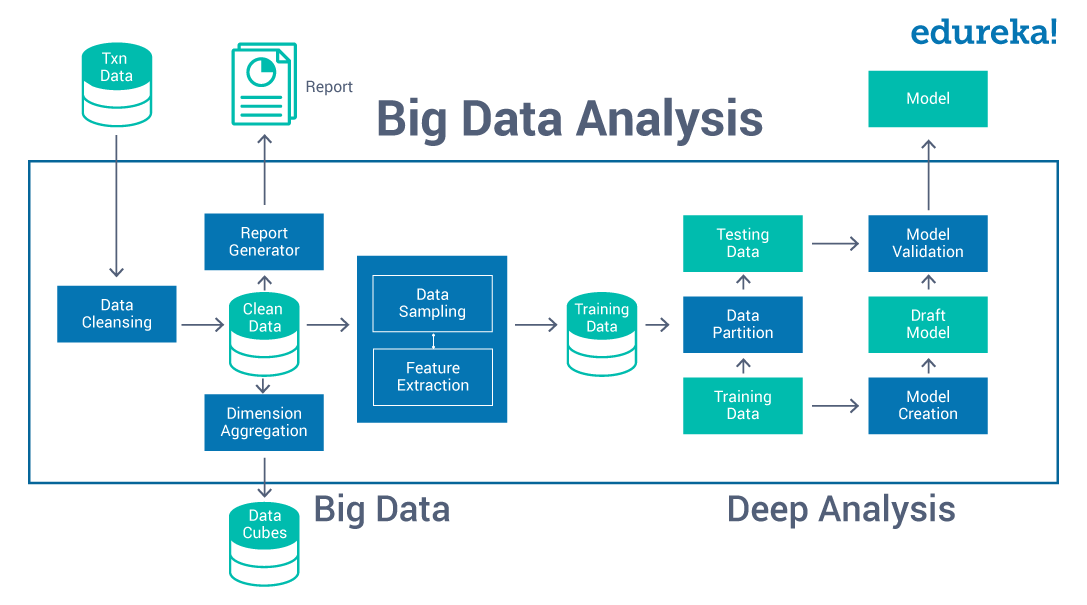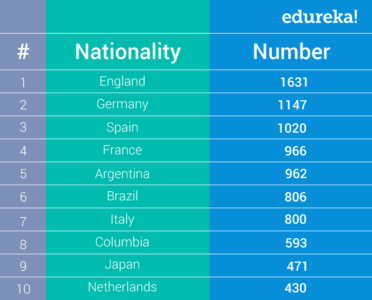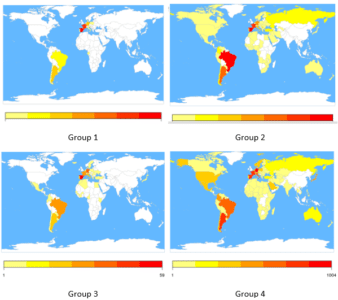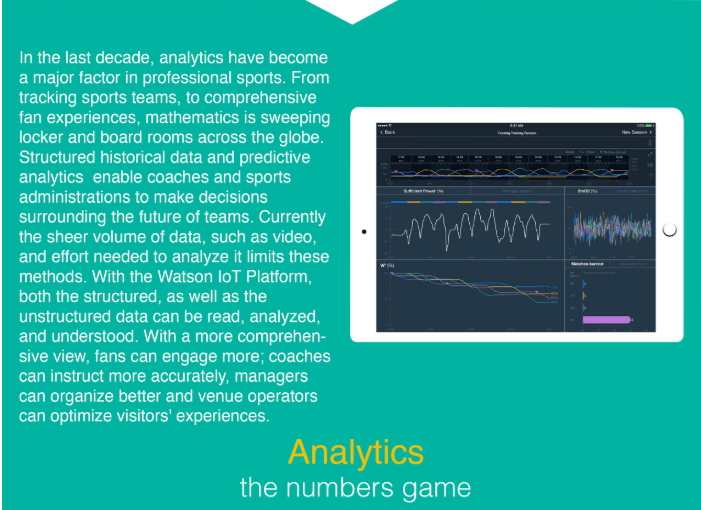Data Science and Machine Learning Internship ...
- 1k Enrolled Learners
- Weekend/Weekday
- Live Class
Football is arguably the most popular sport in the world. According to FIFA.com, a total of 3.2 billion people tuned in to watch the 2014 football World Cup. But, did you know that technology is playing a crucial role in making football what it is today? In fact, modern football can be considered an autonomous IT sector of its own because of the vast applications of new and legacy technologies in the sport.
Technologies being used in the world cup include legacy ones like image recognition and pattern analysis and new-age approaches like artificial intelligence and cloud computing. In fact, for anyone who has the necessary skills and is passionate about the game, a tech job in the field of football could be a dream come true.
In this blog, we’ll discuss five major technologies that are defining the way football is enjoyed as we know it.
There’s a lot of data involved in the field of sports, especially a global tournament like FIFA. For instance, to comprehensively analyze and design predictive algorithms, we require a good 185 fields of data — that’s just the bare minimum for each player.
Not all of the data generated and used for analyses today is structured. Data today comprises unstructured components like videos, images, social media posts, and a lot more. This is called big data. Evidently, simple analyses can be achieved using textual and numeric data, but when it comes to complex algorithms like team performance analytics, player health statistics predictions etc, simple math and traditional tools like Microsoft Excel are not good enough. A lot of analytics in modern day football involve tools like Apache Hadoop, Apache Spark and, Apache Kafka because of the nature of the data.

If you’re a football fan, you might know that Germany won the 2014 FIFA World Cup by destroying its competition. But, did you know that this national team derived its insights by using a complex big data analytics system? Christened Match Insights, this tool was launched in 2012 and developed with German national team general manager, Oliver Bierhoff, leading the charge. This extensive project started taking shape when a group of about 50 students at Deutsche Sporthochschule Koeln, started creating a comprehensive database with stats of all the players participating in the forthcoming tournament. And, as expected, a substantial collection of this data was video from eight different on-field cameras that surround the pitch. The pitch, according to the creators of the tools, is viewed as a grid by the database. In each scenario, every player is assigned a unique identifier. This enables their movements and actions to be tracked digitally which in turn allows anyone to measure key performance indicators, including the number of touches, movement speeds, and average possession time.
Using this data, the students designed an algorithm which devised a final model. This model became the basis for the German team’s fool-proof strategies against all their opponents.
If you are interested in learning more facts about data analytics, this is a good place to start.
This is one field of technology that is obvious in almost all sports as it runs on the forefront of viewership. Derived tables, charts, graphs, and heat-maps, data visualization and business intelligence are fields that have been defining modern sports since the beginning of the 21st century. Everyone is familiar with the bar charts with player scores, the pies showing team distribution, and the ranking tables. All of this is nothing but a comprehensive depiction using data intelligence.
To understand the difference data visualization brings to the table, let’s take a simple example of the number of players from each country registered per team at FIFA right now. Here’s the data, first in the form of a table and then in the form of a world map heat-map.


Just two questions now:
By far, the answer to both questions is the maps. Visualization of data not only makes it appealing to look at, but it also makes it easier to understand and derive insights from. When it comes to data visualization in FIFA, tools like IBM Cognos, Tableau, and QlikView are mostly used.
In the previous two sections, we discussed the analysis and reporting of data. Let’s now look at how this data can be collected.
Most of the current data collection is done using traditional approaches like the X-Y plane or grid analysis on the field for player and ball location, external tracking devices to detect motion and speed etc. But, with smart wearables and IoT taking the world by storm, there has been a lot of research and development on applications of these technologies in sports.
To understand this better, let’s take the example of the German football team’s Match Insights tool we discussed earlier. All the data collected for the final model was derived externally. In fact, as discussed, analyzing player position and movement required the team to work on a set of complex codes. This program then analyzed the video feeds from eight different cameras and then came up with a result. In all honesty, that’s quite a hectic and time-consuming task.
Simplifying this is as effortless as slapping on a smart tracker on each players’ arm. In fact, these smart trackers can not only be used to derive player location, they can also be used to record other stats such as distance travelled, speed of motion, heart-rate, and a lot more. Building on this same idea, ball tracking, line tracking, and other new-age innovations in football have been introduced.

Image Source: IBM
IoT is such a vast field that IBM has a dedicated team working on an extensive project using cognitive IoT, as they call it. The team has devised several hardware and software solutions built over IBM’s famous artificial intelligence, IBM Watson.
We’ve covered three of the major data-related activities there are, but there is another crucial pillar missing – Data Storage.
If this was 2003, there were only a few options for this – local machines or remote instances. But as we already know, the quantity of data collected for any single game today is way too high for one little computer to handle. Moreover, it’s not simple structured data. The best solution to store this kind of data in the cloud. Not only is cloud an easy to setup system, it is also economical when it comes to storage of huge chunks of unstructured data.

Cloud computing allows remote storage of data. Additionally, most of today’s cloud solutions provide integrated tools that can assist in analysis and reporting, as well. Another big advantage of using a cloud system instead of a local machine is the security and privacy issues that cloud computing addresses. Most cloud instances are encrypted with private keys making it difficult to hack or gain unwarranted access to them. And, as the storage can be elastic, there’s never going to be a need to delete old data to make room for newer ones. This will ensure high quality and greater value in historical analyses. Finally, data stored on the cloud can be accessed from any device and any location. This flexibility also makes cloud computing an ideal choice for sports data storage.
Popular cloud solutions used today include Amazon Web Services, Microsoft Azure, IBM Bluemix and Google Cloud Platform.
When it comes to trending technologies, there are very few which can give artificial intelligence and machine learning a run for their money. With the amount of data generated, it is not that difficult to design machine intelligence that can literally predict the future. A few years ago, the FIFA hype was around Paul the octopus who could predict the winners of each match. Sure, the organic creature had a success rate of just above 85 percent, but we are moving into a digital world now and divination isn’t really a part of it.
To make up for the loss of this extraordinary creature, a group of Google data analysts worked on a machine learning system that derived historical insights from a generation’s worth of football games and predicted the outcome of each match in the 2014 FIFA World Cup. The system was successfully able to predict 14 out of 16 matches it was used in, making it almost three percent more efficient than the previously employed sea creature. Moreover, according to its creators, the two misses occurred because of errors and inconsistencies in the data.
To be completely honest, an artificial intelligence or machine learning algorithm doesn’t really predict a winner, it just stacks the favors in order, giving us a probability of each team winning the match.
Using a simple, yet elegant machine learning algorithm, we can arrive at the following result for this year’s FIFA World Cup: *Spoiler Alert*

Algorithm Source: Kaggle
P.S: The lower the number, the better the odds for that team.
Artificial intelligence and machine learning not only can be used for these kinds of analyses, they can also be employed for improving player performance, automating daily-driven business intelligence solutions and a lot more.
The 2018 football world cup is here! As much as all of us love the sport, we hope that learning about the technologies that are behind making the sport what it is helps us appreciate it more.
These are the five popular technologies in FIFA that are changing the game as we know it. Each of them offers its fair share of advantages making the sport better than it was before — for players and fans alike. What’s more is if you have the necessary skill-set, you could even get into an IT-related job in the field of sports.
We hope you liked our coverage of technologies in FIFA, if you know of any more applications of trending technologies in FIFA or sports, in general, do let us know by writing to us in the comments section below. Be sure to subscribe to our blog for more FIFA and technology-related coverage.
| Course Name | Date | |
|---|---|---|
| Data Analytics with R Programming Certification Training | Class Starts on 11th February,2023 11th February SAT&SUN (Weekend Batch) | View Details |
| Data Analytics with R Programming Certification Training | Class Starts on 4th March,2023 4th March SAT&SUN (Weekend Batch) | View Details |
 REGISTER FOR FREE WEBINAR
REGISTER FOR FREE WEBINAR  Thank you for registering Join Edureka Meetup community for 100+ Free Webinars each month JOIN MEETUP GROUP
Thank you for registering Join Edureka Meetup community for 100+ Free Webinars each month JOIN MEETUP GROUP
edureka.co
